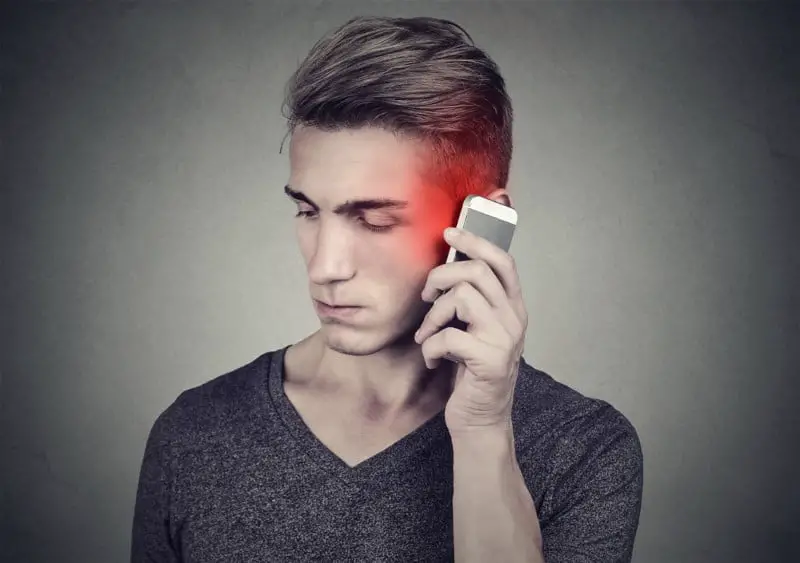Bluetooth is a wireless technology designed to allow devices to communicate with each other and share data. Bluetooth uses wireless technology to transmit signals using Radio Frequency (RF) waves. They emit a dangerous amount of electromagnetic radiation. But how much EMF does Bluetooth actually emit?
The amount of radiation emitted by Bluetooth devices is similar to that of a microwave but significantly lower than that emitted by cell phones. Though Bluetooth devices and wireless headphones are known to emit low electromagnetic radiation, where they are used on the body is the biggest concern.
Half of the radiation you are exposed to from your cell phone is received by your head. There are a lot of scientific studies that link emitted Radio Frequency Radiation (RFR) to cancer. The World Health Organization (WHO) classifies this type of radiation as “carcinogenic”. Bluetooth operates at a frequency of 2.45 GHz, which is the same frequency of other devices emitting RF radiation such as the microwave.
The wireless radio frequency wave emitted by Bluetooth headsets is known as microwave radiation. Microwave frequencies generate short wavelengths and they’re great for data transfer and voice communication.
According to research by Kevin Mottus of the US Brain Tumor Association, RFR plays a big role in the electromagnetic spectrum, and the higher the radio frequency, the more dangerous the radiation will be to people and other living organisms.
Bluetooth has a higher frequency compared to some cellular phones. However, having a low powered RFR signal which is constant is as dangerous as having a more powerful RFR for a short period of time. Bluetooth devices will continue to emit RFR as long as they are on and have a higher frequency than your 4G cellular phone.
How Bluetooth Devices Work
The Bluetooth devices transmit using pulses of short radio wavelength. The majority of Bluetooth devices operate at a range of between 2.4 to 2.48 GHz. The devices transmit data using small packets at a speed of 800 times per second.
Bluetooth uses wireless technology to transmit data over a short distances, and they have varying ranges depending how powerful they are. The Class of the device determines both the range, the power, and the EMF levels you can expect. Using a device of a lower class will minimize your risk. We discuss the Classes of devices in detail later.
All Bluetooth devices must comply with regulatory standards for Bluetooth technology in the country they are used, as well as meet the requirements and patents set by the Bluetooth Special Interest Group (SIG).
Bluetooth Radiation
Some government regulatory agencies classify Bluetooth as “safe” based on the standards of Specific Absorption Rate (SAR). However, the amount of radiation emitted by Bluetooth devices is much more than the SAR recommended standards.
Some researchers focus on the fact that Bluetooth devices emit non-thermal and non-ionizing radiation, and they rely on the information that it’s not harmful. Further research indicates non-ionizing radiation is very harmful.
Connecting headsets with cell phones via Bluetooth results in the emission of microwave radiation. Microwave radiation consists of short wavelengths which are transmitted via pulses of data at very high speed. The radiation generated can penetrate through human tissue and negatively affect your DNA cells.
Another study indicates that using a Bluetooth headset while your cellular phone is inside your pants pockets can affect a man’s sperm quality and quantity. The amount of radiation emitted by both your phone and your headset increases the risk of exposure. The close proximity of the Bluetooth device and the headset makes the radiation more harmful to you.
Storing your phone in your pockets, even if it’s for an hour can cause serious damage.
Is Bluetooth Safe for the Brain?
EMF radiation from Bluetooth headphones can affect your brain cells and increases the risk of developing brain cancer. Therefore, any device using Bluetooth technology to transfer data or communicate with another Bluetooth device can have negative health complications even if they emit radiation at low rates.
How to Minimize Bluetooth Exposure
Understanding the three classes of Bluetooth will help you minimize your risk of exposure to Bluetooth devices. The distance between two transmitting Bluetooth devices determines the power of the transmitter.
There are three classes of Bluetooth and they include:
- Class 1: Devices classified as Class 1 transmitters are very powerful and they emit the highest Bluetooth radiation. The Bluetooth can transmit at a range of 100 meters with a transmission power of 100 mW (milliwatts).
- Class 2: Class 2 transmitters include Bluetooth headset transmitters and cell phone devices that transmit at a range of 10 meters with a peak transmission power of 2.5 mW.
- Class 3: These are the least powerful Bluetooth devices, and they emit the least amount of Bluetooth radiation. Class 3 transmitters operate at a rate of 1 mW and have a range of 10 meters.
Some Bluetooth devices can emit radiation at a rate of 0.23 Watts per kilogram while others are worse and can emit more radiation than some SAR cell phones.
Knowing the amount of radiation you’re exposed to every time you turn on your Bluetooth device will enable you to come up with appropriate measures to minimize the risk of exposure.
One of the best methods of minimizing exposure to Bluetooth radiation is by using Air tube headsets and Ferrite beads instead of using Bluetooth headsets. You can also connect your cell phone to the car stereo instead of using Bluetooth.
The ferrite beads protect brain exposure to RF radiation. Ensure all headsets have ferrite beads to protect you from Bluetooth radiation.
If you want to learn more about whether AirPods emit radiation or not, read this article.
Is Using a Bluetooth Headset Better Than Holding A Cell Phone To Your Ear?
Yes, a Bluetooth headset will emit less radiation compared to radiation from your cell phone. AirPod wireless headphones are the exception. For this reason, using a Bluetooth headset may be a good option. This will reduce the amount of radiation you’re exposed to when holding the cell phone next to your ears. However, if the phone is still near you, for example, in your pocket, it will emit a lot of radiation into the body anyway.
Bluetooth devices and cell phones rely on microwave radiation for sending and receiving data. A cell phone also emits microwave radiation that can be transmitted up to 10 miles away. Bluetooth technology can transmit radiation signals to another wireless device located between 10 and 30 feet away.
For example, you can plug an Air tube headset to your Bluetooth dongle instead of connecting it with your smartphone. The headset receives the audio signals from the device using Bluetooth technology. As a result, you are able to keep a safe distance between you and your cell phone or tablet.
Connecting an Air tube headset to a Bluetooth dongle makes it easy to control the amount of radiation and also reduce power radiation from the Bluetooth dongle. An Air tube headset helps maintain distance between a conductive metal, a transmitter, and the earbuds. It delivers sound waves without having any electronic device connected in your ear, thereby helping you reduce electromagnetic radiation that can be transmitted into your head causing brain damage.
If you’re using a Bluetooth headset, always make sure to maintain a safe distance between you and the phone. You can put the phone on your dashboard as you drive or put it on a shelf if you’re in the office.
A wired headset can act as an antenna for EMF radiation and make you absorb radiation in your brain, but it is way less than what you get from wireless devices. Avoid the prolonged use of headsets, especially wireless ones. Alternatively, enable the speaker function on your phone. This will create distance between you and the source of the EMF, your cell phone.
If you have to use a headset, look for the Air tube headphones or earbuds, since these devices don’t have any wireless components that can act as a conductor for EMF. Instead, it uses a hollow tube through which the sound waves travel.
As a result, you can maintain distance from the EMF radiation emitted by your cell phone and headset.
Summary
Bluetooth technology is very dangerous since it emits radiation similar to that of microwaves. The EMF that radiates from Bluetooth technology is not as powerful as the EMF that radiates from your cell phone. However, when you use a Bluetooth headset, you are exposed to the EMF waves very close to your brain.
If you have electromagnetic hypersensitivity (EHS), you are more likely to experience a myriad of radiation symptoms. Constant use of Bluetooth devices will expose you to EMF radiation and this can have health complications for you in the long run.
Don’t assume that just because you don’t feel any EMF radiation effects that you’re safe. If you use wireless Bluetooth devices, the EMF radiation that they emit is slowly affecting you. To know how much radiation you’re exposed to from your Bluetooth device, use an EMF meter to measure the radiation.


